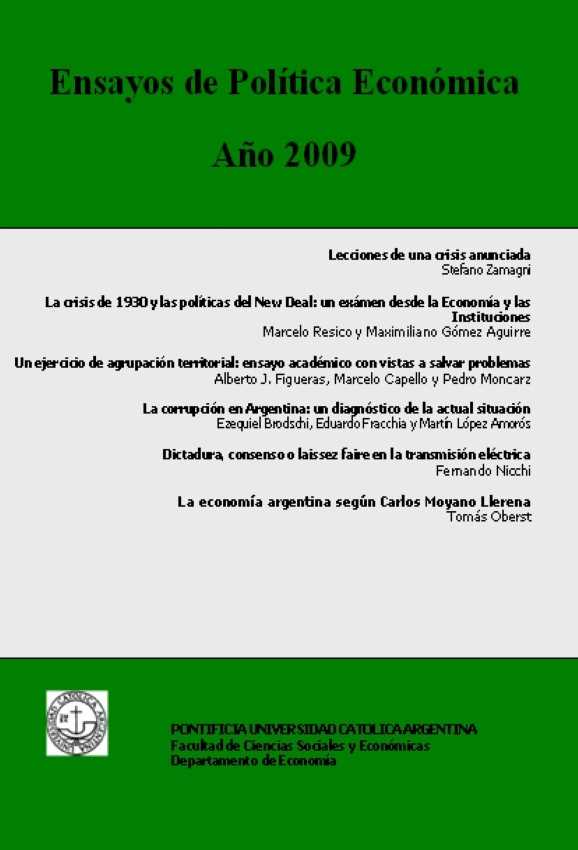La crisis de 1930 y las políticas del New Deal. Un examen desde la economía y las instituciones
Palabras clave:
Gran depresión, New Deal, institucionesResumen
La presente investigación consiste en un análisis, desde la perspectiva de la economía y las instituciones, de las políticas del New Deal, implementado por Franklin D. Roosevelt en los Estados Unidos durante la crisis económica de los años 30.
Para dicho análisis, se presentan los elementos principales de la crisis de 1930; luego se realiza
un estudio de las políticas económicas aplicadas en el contexto de un marco de gran innovación
institucional; y se concluye evaluando las políticas expuestas, tanto desde el enfoque de sus
resultados macroeconómicos como desde el de su desempeño institucional.
De esta manera, el presente documento incluye un diagnóstico histórico del contexto norteamericano en aquel entonces y resalta los aspectos que motivaron a dicha administración a la aplicación del New Deal.
Finalmente, se realiza un análisis del impacto macroeconómico de las políticas aplicadas. La conclusión sintetiza las principales enseñanzas de la experiencia desde la perspectiva de política económica y del diseño de la regulación, para concluir con algunas reflexiones acerca de su posible implementación en la actualidad.
Descargas
Citas
Barbour, G. B. (1937). “The Tennessee Valley Project”, The Geographical Journal, vol. 89, Nº5, mayo.
Coole, H. L. and Ohanian Lee, E. (1999). “The Great Depression in the United States from a neoclassical perspective”, Federal Reserve of Minneapolis.
Coole, H. L. and Ohanian Lee, E. (2004). “New Deal Policies and the persistence of the Great Depression: A General Equilibrium Analysis”, Journal of Political Economy, vol. 112, Nº 4.
Department of commerce, Bureau of the census Washington (1961). “Historical statistics of the United States colonial time to 1957”.
Eden, R. (ed.) (1989). The New Deal and Its Legacy.
Eggertsson, G. B. (2006). “Was the New Deal Contractionary?, Federal Reserve Bank of New York Staff Reports, N° 264, octubre.
Federal Reserve of Minneapolis (2007). “Great Depressions of the twentieth century”.
Glaeser, E. L. and Shleifer, A. (2003). “The Rise of the Regulatory State,” Journal of Economic Literature, Vol. 41, Nº 2, junio 2003, págs. 401-425.
Graham, O. L. Jr. and Robinson Wander, M. (1985). Franklin D. Roosevelt: His Life and Times, New York, Da Capo Press.
Hamby, A. L. (2004). For the Survival of Democracy: Franklin Roosevelt and the World Crisis of the 1930s.
Keller, M. (ed.) (1963). The New Deal: What Was It?.
Leuchtenbrug, W. E.(1963). Franklin D. Roosevelt and the New Deal, New York, Harper and Row.
Leuchtenbrug, W. E. (1995). The Supreme Court Reborn.
McGraw, T. K. (1975). “Regulation in America: A Review Article”, The Business History Review, vol. 49, Nº 2, Summer, págs. 159-183.
McGraw, T. K. (1984). Prophets of Regulation, Cambridge, Belknap Harvard University Press.
Rauch, B. (1944). History of the New Deal 1933–1938.
Rauchway, E. (2007). The Great Depression & The New Deal: A very Short Introduction, Oxford University Press.
Schlesinger, A. Jr. (1959). The Coming of the New Deal.
Schlesinger, A. Jr. (1960). The Politics of Upheaval.
White, G. E. (2001). The Constitution and the New Deal.
Pine, J. (ed.) (2001). Wit and Wisdom of the American Presidents, New York, Dover Publications Inc.
Descargas
Publicado
Cómo citar
Número
Sección
Licencia








